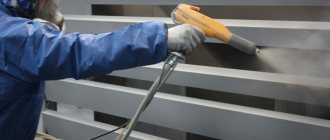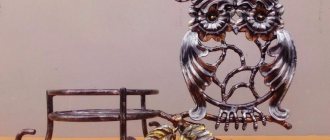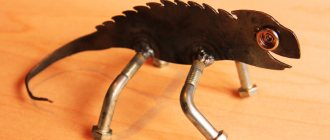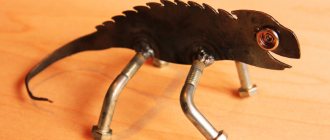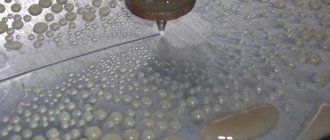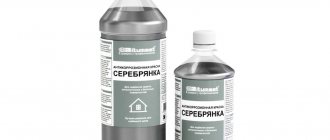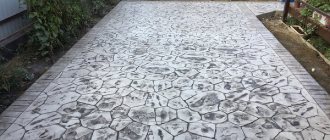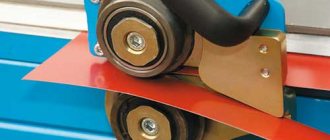Painting is a popular way to change the color of metal. To obtain the desired result, it is important to strictly follow the technology and select the paint, taking into account the operating conditions of the enamel. Painting metal allows you to change the design of the surface, protect the material from the destructive effects of moisture and the formation of rust.
Painting metal surfaces
The essence and features of the method
Painting of metal products was initially used to change color and give surfaces an interesting shade, but simple enamel quickly cracked and rust appeared underneath. Therefore, manufacturers began to develop new types of coloring compounds that could protect the metal from corrosion.
On sale you can find different types of paint that is suitable for metal surfaces. It can be applied in different ways. In this case, hand tools and industrial equipment are used.
Paint selection
Just a few years ago, oil paints were used to paint metal structures. Nowadays, a large number of different options have appeared that can be used instead of this traditional method. Craftsmen now have access to acrylic materials based on epoxy and alkyd bases, those that can be diluted with water.
The main thing is to choose a mixture that includes anti-corrosion components. The ideal option is one that contains rust converters. Of course, the price tag for them is a little higher, but this coating will last a very long time.
Is it possible to paint metal?
Metal structures are often made of black iron. Since this material oxidizes very quickly, it must be protected from moisture and rust. For this purpose, special anti-corrosion compounds or metal paint can be used.
Galvanized metals, thanks to a layer of zinc and chromium, are already protected from rust. The protective layer retains its integrity for up to 15 years. If you want to increase this figure, the surfaces can be additionally painted.
Painted disc
Padding
The next step is to apply the primer material. It helps to avoid the influence of an aggressive environment and protects against rust. In addition, this particular layer will help create maximum adhesion to the paint.
To work with ferrous metals, select materials with anti-corrosion coating. You can apply it in any way (using a brush, roller, spray).
Application methods
To apply paint you can use:
- Paint brush. Suitable for painting small parts. You can find brushes of different sizes on sale. The bristles can be natural or synthetic. For access to hard-to-reach places, the tool is equipped with an elongated curved handle.
- Roller. Suitable for painting large flat surfaces.
- Sprayers. The second name for the spray gun. A compressor is used to operate them. The coloring composition is supplied under pressure. The equipment is used by large enterprises, car repair shops, carpentry, and blacksmith shops.
- Containers for dipping metal workpieces. This method makes it easy to paint parts with complex shapes.
Modern technology - powder coating of metal. The blanks are placed in a closed spray booth and covered with a layer of paint. Its particles receive a negative electrical charge and are attracted to the working surface, creating a dense, uniform layer. After applying the powder, the workpiece is placed in an oven so that the decorative layer bakes and becomes monolithic.
Paint brush
Advantages of wood-look powder coating
Decorating a metal profile offers the consumer a number of advantages over painting it in a single color using the traditional method. The mechanical strength of powder coating is higher, and the coloring itself, imitating wood, marble or stone, is practically no different from natural materials. The resulting surface structure allows you to hide defects in the base, if any, and the product itself is lightweight, which is especially convenient if you are not painting it like wood, but stylizing it like stone. A profile decorated in this way can be used in a wide variety of areas where it is necessary to combine strength and durability with aesthetics.
Types of coloring compositions
Varieties:
- Oily. Suitable for decorative finishing of surfaces indoors and outdoors. Made from organic substances. Before applying oil paint, you need to cover the working surface with primer. The main disadvantage is the persistent pungent odor. Such enamels can only be used in ventilated areas.
- Epoxy. Manufactured on the basis of silicone resin. In order for the composition to set, different hardeners are used. Can only be used for exterior painting as they are highly toxic. It is difficult to work with epoxy paints, but the finished coating reliably protects surfaces from rust.
- Acrylic. The basis of such paints are polymers. Suitable for painting metal parts indoors.
- Alkyd. Used for external and internal work. Easy to apply, no primer required.
- Rubber. Special dyes used to coat the external sides of building walls and roofs. Withstands prolonged exposure to moisture and ultraviolet radiation.
For metal, you need to choose paints that protect against rust. Before painting, the surfaces must be coated with a primer containing a high zinc content.
How to calculate paint consumption?
The paint consumption for metal can be found on the container. It is indicated on the back of the label or front side. If for some reason there is no designation, you need to know that 1 liter is enough for about 14 m2.
Consumption depends on the application method, the presence of complex elements, surface structure, and type of paint.
How to paint metal - applying primer
There are about a dozen ways to apply paint without removing rust. Most of this group of technologies involves factory methods of processing and preparing products; as a rule, we are talking about protective processing of heavy metal structures for construction. In private, you can use two options:
- Coat with expensive two-component paint, having previously treated the surface with a passivating composition, usually containing orthophosphoric acid.
- Coating with a universal primer suitable for application against rust, followed by painting with alkyd or polyurethane enamel.
The practical difference between these two methods lies in the cost of materials and the durability of the protective coating. Two-component paints are applied in a thicker layer and form a durable film. Unlike conventional enamels, this coating does not allow even minimal gas exchange; air and water vapor do not penetrate the rust. In addition, the paint has a higher hardness and at the same time retains elasticity; it can withstand even very significant swelling of rust. In this case, the layer of corroded iron is constantly compacted, and the reaction subsides.
How to paint metal, a budget type of coating in the form of primer and enamel ensures the safety of the product for no more than 2-3 years and requires regular updating. The latter consists of cleaning and degreasing the enamel layer and then applying another one. The essence is the same: over time, the thickness of the paint layer becomes large enough to ensure complete isolation of the product from atmospheric influences.
Advantages and disadvantages of the method
The pros and cons of painting metal depend on the type of paint composition used. Advantages of painting metal surfaces, provided the technology is followed:
- Getting the required shade. You can find different colors on sale.
- Availability of consumables.
- Easy to apply paint using a brush or roller.
- Protection against rust formation.
Flaws:
- Many types of coloring compounds emit a persistent, unpleasant odor. The room needs to be ventilated for a long time.
- For powder coating you will need special equipment, a spray booth.
- Not all types of paint protect metal from corrosion.
Most of the shortcomings can be leveled out if you buy a high-quality coloring composition and carry out the work strictly following the technology.
“Chasing” on any surface
The most popular techniques for creating “metallic” objects boil down to painting them and giving them relief. To make the effect believable, craftsmen use several shades of paint, making the recesses darker and the protrusions lighter. In this way, you can achieve a texture that imitates metal with a touch of patina.
Box decorated with metal look with patina
Important! With the help of such processing, you can simultaneously hide all surface defects or update old products.
To create embossing you will need any product, for example, a wooden board, as well as consumables and other accessories:
- dark putty (black, brown);
- paints – dark brown, black, dark green or turquoise;
- metallic paints (copper, brass, gold, etc.) in two tones – dark and light;
- mold for a three-dimensional pattern;
- water-based acrylic varnish;
- self-hardening mass or polymer clay;
- tassels;
- small spatula;
- knife;
- disposable plates;
- wet wipes.
Set of acrylic paints
It is best to take acrylic paints for work. Gouache or standard construction tinted compounds are less suitable because they change color after drying. Acrylic retains the shade and creates a durable film that does not dissolve from the varnish.
On a note! For varnishing, you should not buy yacht varnish - many of them give unnecessary yellowness.
Progress
First, take a dark putty and spread a thin layer of it on the item being processed. The surface is not smoothed too smoothly - the embossing cannot look perfectly smooth.
Applying putty
To make a relief pattern, use a mold. The self-hardening mass is placed in a mold, pressed well until the smallest details are imprinted, and then the excess is cut off with a knife.
The resulting workpiece is taken out of the mold and immediately, before it hardens, pressed into the putty. Leave the product to dry for 12 hours.
After drying, the surface covered with putty begins to be painted. First of all, apply a layer of dark brown paint and let it dry. If the paint is a little cracked, it’s not a big deal - the defects will still be filled with a second layer of paintwork.
Painting the surface being processed to imitate embossing
Next comes acrylic varnish - it will fix the paint and prevent it from mixing with other shades. As the varnish dries, do this:
- Cover the board with a thin layer of turquoise or green paint so that it penetrates into the smallest cracks and holes (the paint is diluted a little with water in advance for ease of smearing).
- Take wet wipes or a regular wet cloth and carefully wipe off the paint in an arbitrary manner (don’t leave too much green, as it should imitate patina).
- Re-coat the product with varnish.
- Dilute black paint with a drop of water and apply it to the entire surface of the board, after which part of the paintwork is wiped off again with napkins (the blackness should remain in some of the slits to give the workpiece shading).
- After the paint has dried, a layer of acrylic varnish is applied.
- Take a little paint with a dark metallic shade onto a dry, hard brush, place it almost horizontally and apply the product with light movements only to the raised areas.
- Using paint with a light metallic tint, paint the most elevated areas with superficial strokes.
The finished board looks amazing and strongly resembles a metal surface with a patina. This product will be a wonderful gift and interior decoration.
Coloring at home
If necessary, metal products can be painted yourself. To do this, you need to choose a method for applying enamel, prepare the required tools and surfaces, and apply the composition.
Tools and equipment
For the classic method of painting metal, you need to prepare:
- roller, brushes of different widths;
- paint container;
- the coloring composition must be shaded;
- primer for metal.
Additionally, you will need masking tape and plastic film.
Surface preparation
Do not apply paint to unprepared surfaces. Before starting work, you need to perform several steps:
- Clean the metal from dirt and rust. To do this, you can use a grinder, grinder, metal brush or acid.
- Degrease surfaces with solvent.
- Putty the uneven areas.
After the preparatory work, you can apply a primer.
Preparation of material
Application of the composition
Surfaces that do not need to be painted should be covered with plastic film. The edges must be covered with masking tape. Painting with a brush is easy. It needs to be dipped 1/3 of the way. The number of layers depends on the desired result.
Do-it-yourself painting of metal products - surface preparation
The result you get also depends on how correctly you prepared the surface of the product. First of all, it is necessary to clean the structure of any debris, deposits, old layers of paint and varnish. Scrapers are usually used for work, but you can use sandpaper or a metal sponge.
Stains of salt, oil and fat - everything must be washed off. It's best to use non-abrasive cleaners, even a soap and water solution. After this, be sure to rinse the surface with clean water and let it dry.
If you have to work with a very large product, you can use an acid-acetylene torch. As a result, the paint will burn and the rust layer will fall off.
If you cannot remove the rust, you can use a converter. This is a mixture prepared on the basis of phosphoric acid. The affected part of the structure is covered with the mixture and left for more than 3 hours. After this, you need to rinse everything off with water and dry it.
Recommendations and safety precautions
Safety regulations:
- The room in which the work will take place must be well ventilated.
- If the solvent is spilled, the resulting stain must be covered with sand.
- You should work in a respirator, safety glasses, gloves, and long-sleeved overalls.
- The remaining paint must be poured into a separate container and sealed tightly.
- Used jars should be washed or thrown away.
Do not pour any remaining paint down the drain.
Metal painting is performed to change the shade of the product and protect the material from rust. To obtain the desired result, you need to choose one of the possible methods of applying the coloring composition and select the paint. Attention should also be paid to the preparation of metal surfaces. Without it, the decorative coating will be destroyed in a short period of time.
When is it possible to paint metal without stripping?
The general complex of preparing metal products for painting includes stripping, grinding, coating with primer and a layer of protective enamel. However, stripping is not always possible; in some cases it is easier to apply a coating with special characteristics. Let's try to figure it out.
We discussed above the first criterion that influences the possibility of painting against rust - the density of the rusty layer. More precisely, the product’s ability to accumulate corrosion activators. Over time, the variety and content of active chemical compounds increases, which is why, even in the absence of oxygen and moisture, reactions will still occur inside. It is impossible to predict how paintwork materials will behave under such operating conditions.
Another important factor is surface quality. A small, uniform layer of rust, similar to powder, allows the paint to penetrate to the surface of the metal and firmly contact the “body” of the product. But the presence of swellings and peelings on the rusty layer is almost guaranteed to lead to the destruction of the protective coating. Oil residues have a negative impact: if the rolled product has not been degreased, oil impurities can have an unpredictable effect on the protective layer.
Bronze metal painting
Bronze coating is one of the most visually impressive. Therefore, people often strive to recreate it. And there are several ways to do this, and they all involve the use of bronze paint.
First of all, the surface is prepared. Dirt, grease and rust are removed. After this, a layer of metal primer is applied to it, which will increase the adhesion of the layers applied above. At the third stage, bronze metallized paint is applied in 2-3 layers.
If you want to give this bronze layer the effect of antiquity, then the recesses must be treated with patina, which allows you to get the effect of darkening over time. After this, glazing is carried out, during which we go over the protruding elements and those places that are characterized by abrasions with white paint. After the latter has dried, a transparent varnish is applied to seal the effect.
Painting plastic to look like wood
There is nothing difficult in carrying out this task. But in order not to spoil the material and make the coating durable, you need to know some quality characteristics of the materials:
- There are types of plastic that cannot be painted;
- after sanding, the plastic is coated with a primer;
- Some types of paints that serve as a solvent for plastic cannot be used for painting.
To achieve a perfect resemblance to wood, you should not use a roller during the painting process. It is best to use a wide, medium-hard brush.
As a result of this painting, the white color of the doors becomes the color of wood. In the interior of the room, a wooden door looks much richer and more prestigious. While maintaining the quality of plastic, the external design of the doors takes on the appearance of a wooden product.
A thin film is applied to the plastic, which imitates the pattern of wood materials. This gives the door a qualitatively new design solution, while the structure of the material remains the same. When the paint dries, it forms a durable protective layer, similar in appearance to natural wood. A good result is obtained after painting with acrylic paints and varnishes.
On video: how to paint various materials to look like wood.
Antique painting
One of the most popular ways to paint black metal is the antique effect. In this case, several coating options are applied to the metal surface in a certain order. But first, the metal itself must be properly prepared. It must be cleaned of corrosion, sanded, and dirt and grease are removed. Only when you are confident that the surface is clean can you begin the process, which is divided into several stages:
- Using a brush, apply metallic paint to the surface. Don't be afraid to do it casually, as this will only help with the effect we are creating;
- Once the first layer has completely dried, it is necessary to apply a craquelure primer. The latter allows you to obtain a layer of transparent film created from polymers;
- The craquelure coating is applied after the primer layer has dried, which allows you to get characteristic cracks, similar to those that appear on things that have been used for decades and even centuries.
Important! Instead of a craquelure composition, the effect of antiquity can be achieved by applying burnt umber to the paint. In this case, it is best to work with a dry cloth, and remove the residue after the paint layer has dried.
Advice for those who are planning to paint a metal surface at sub-zero temperatures
Although this advice may apply more to ordinary painting than decorative painting, situations are different. For example, you need to immediately paint a part that has just been brought in from the cold. Therefore, we will give some tips:
- The best way to paint in cold weather is to use alkyd enamels with a jelly-like consistency that have high adhesion (the ability to penetrate the surface structure);
- Painting a surface cooled to temperatures below +5 degrees Celsius should be done exclusively with preliminary treatment of this very surface with a torch or heat gun. Otherwise, condensation will form on the surface on which the paint simply will not adhere;
- If the room itself is cold when painting, the drying time of the layer can increase several times, which is especially unpleasant for decorative painting. Therefore, it is recommended to install a heat gun and cover the surface with film.
